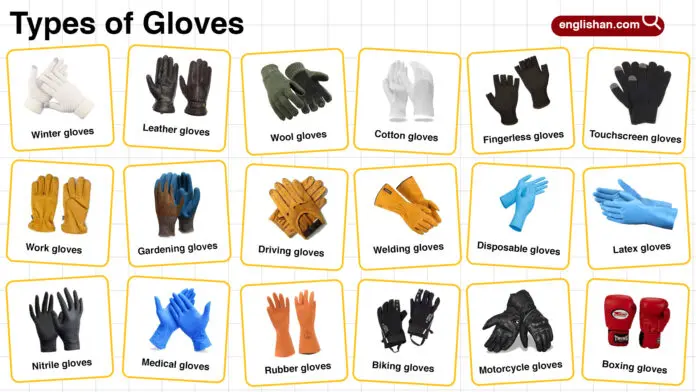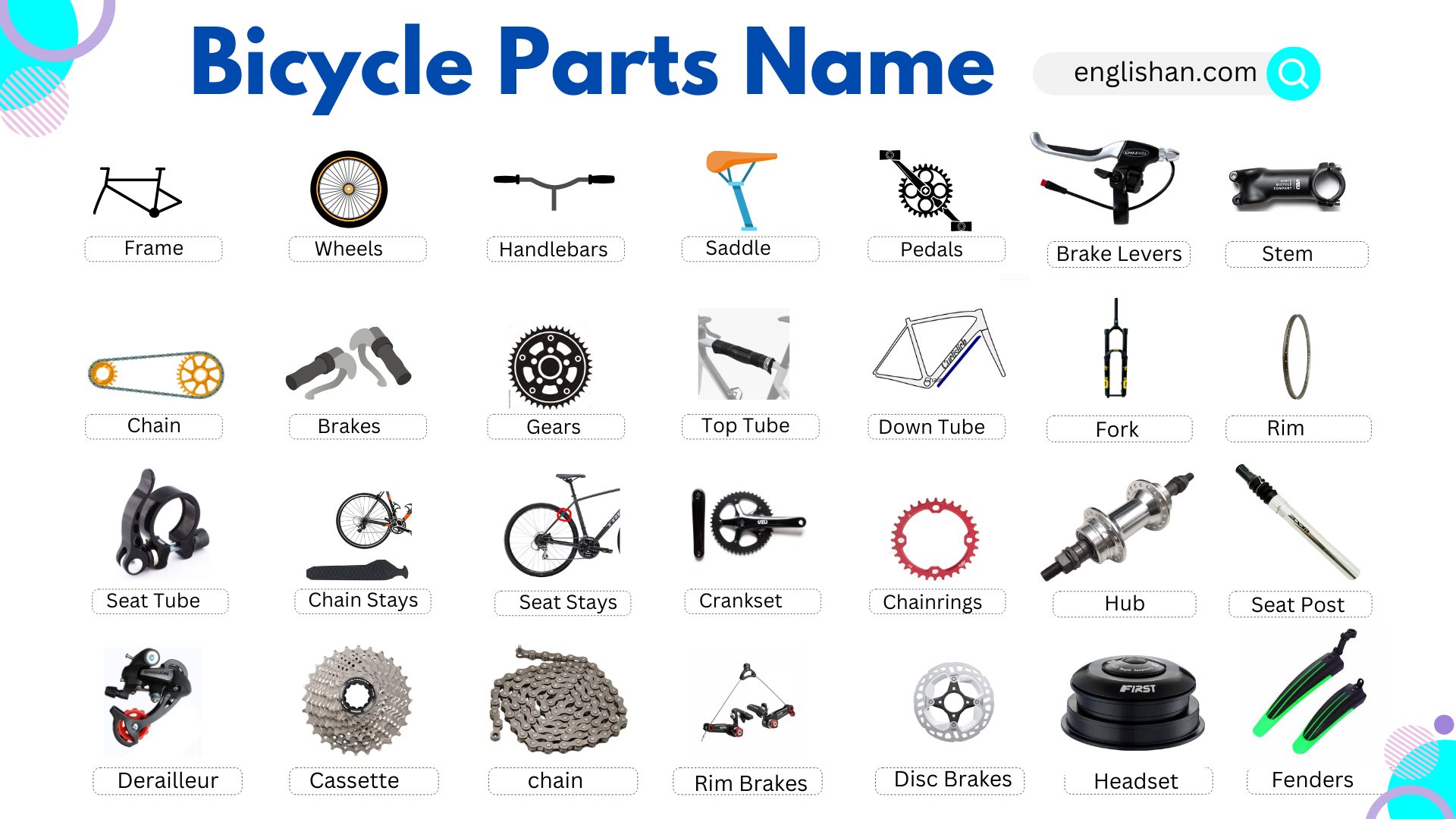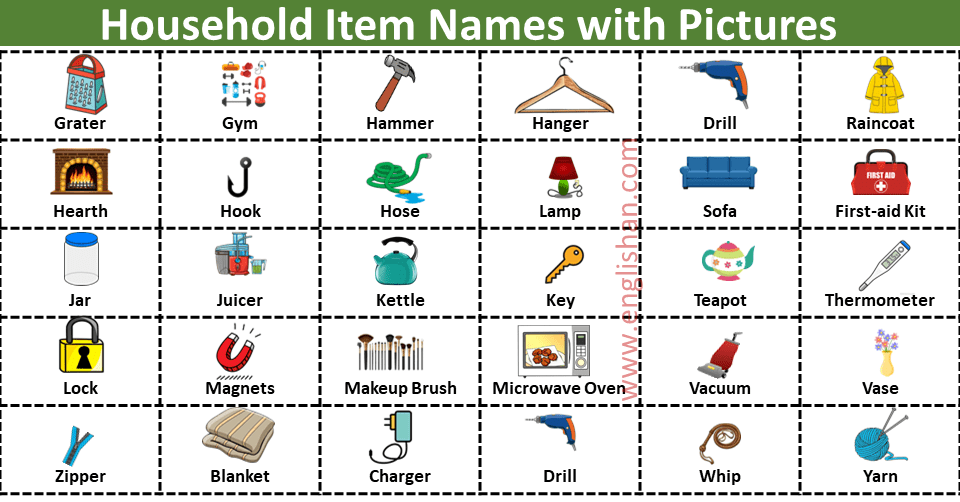Contents
Gloves come in different types, serving various purposes, from protection to style. Learning the names of gloves with pictures helps English learners improve their vocabulary effortlessly. This guide provides a categorized list of gloves with clear explanations.
Explore more illustrated vocabulary lessons in our Picture Vocabulary section.
Types of Gloves
Gloves are categorized based on material, function, and activity. Below are the most common types of gloves explained in simple words.
Material-Based Gloves
Leather Gloves
Made from leather, these gloves provide durability and protection for formal wear and outdoor use. They are commonly used for driving, fashion, and work-related tasks where extra grip and hand safety are needed.
Wool Gloves
These gloves are made of wool and provide warmth, best for winter conditions. Wool gloves help retain heat and keep hands comfortable even in freezing temperatures.
Cotton Gloves
Cotton gloves are lightweight and breathable, often used for comfort and mild protection. They are ideal for sensitive skin and used for handling delicate objects like artwork or jewelry.
Rubber Gloves
Made from rubber, these gloves are waterproof and commonly used for cleaning tasks. Rubber gloves provide a protective barrier against harsh chemicals and keep hands dry when washing dishes or cleaning surfaces.
Latex Gloves
Thin, stretchy gloves used in medical and laboratory environments for hygiene. They provide a snug fit and excellent tactile sensitivity, making them suitable for healthcare workers and food handlers.
Nitrile Gloves
An alternative to latex, nitrile gloves are more resistant to chemicals and punctures. They are frequently used in medical, industrial, and automotive settings due to their durability and hypoallergenic properties.
Function-Based Gloves
Winter Gloves
Thick and insulated, winter gloves help keep hands warm in cold weather. They are designed with thermal lining to trap heat and often come with waterproof exteriors for added protection against snow and rain.
Touchscreen Gloves
These gloves have special fingertips that allow users to use touchscreen devices. The conductive material on the fingertips enables interaction with smartphone and tablet screens without removing the gloves.
Work Gloves
Designed for heavy-duty tasks, these gloves protect hands from injuries. Work gloves are commonly used in construction, woodworking, and manufacturing to prevent cuts, blisters, and burns.
Gardening Gloves
Gardening gloves prevent scratches and dirt, keeping hands safe while working with plants. They are made of durable material to protect against thorns, splinters, and soil contamination.
Driving Gloves
Made for better grip and comfort, driving gloves help in handling the steering wheel smoothly. They reduce hand fatigue and provide extra grip, especially useful in long-distance driving and racing.
Welding Gloves
These gloves protect against heat and sparks, used by welders for safety. They are made of thick, heat-resistant material to shield hands from burns while working with metal.
Disposable Gloves
Used once and thrown away, disposable gloves are essential for hygiene and protection. They are commonly used in medical, food handling, and cleaning industries to prevent contamination.
Medical Gloves
Sterile gloves used by doctors and nurses for safe handling of patients. They prevent the spread of infections and are often made from latex, nitrile, or vinyl.
Sports & Activity Gloves
Biking Gloves
Provide grip and hand protection for cyclists and bikers. These gloves absorb vibrations, reduce hand strain, and improve control while riding on rough terrain.
Motorcycle Gloves
These gloves protect hands while riding a motorcycle, ensuring comfort and safety. They are reinforced with knuckle protection and padded palms to reduce impact in case of falls.
Boxing Gloves
Padded gloves used in boxing to protect hands and reduce injury risk. Boxing gloves distribute the force of punches evenly, preventing damage to the fingers and wrists.
MMA Gloves
Lighter than boxing gloves, MMA gloves provide flexibility for grappling. These gloves allow fingers to move freely, making them suitable for striking and submission techniques.
Weightlifting Gloves
Designed to prevent blisters and improve grip during weight training. Weightlifting gloves provide extra wrist support, reducing strain on the hands while lifting heavy weights.
Baseball Gloves
Large gloves used by baseball players to catch and hold the ball. These gloves have a deep pocket and reinforced padding to help fielders and catchers handle fast-moving balls.
Goalkeeper Gloves
Used in football, these gloves help goalkeepers grip the ball better. They have padded fingers and palms to absorb impact and enhance ball control during matches.
Golf Gloves
Golf gloves improve grip and reduce hand strain while swinging a golf club. They provide better control, preventing the club from slipping due to sweat.
Ski Gloves
Designed to keep hands warm in cold, snowy conditions while skiing. These gloves are insulated and waterproof, ensuring comfort during extreme winter sports.
Tactical Gloves
Tactical gloves offer extra protection for military, security, and outdoor activities. They are designed with reinforced knuckles and breathable fabric for durability and comfort.
Archery Gloves
These gloves protect the fingers while pulling and releasing the bowstring. They help reduce friction and improve accuracy in archery competitions.
Interesting Facts About Gloves
Gloves have been used for centuries in different cultures and for various purposes. Here are some fun facts:
- The earliest gloves date back to the ancient Egyptians, used for protection and fashion.
- Medieval knights wore metal-plated gloves called gauntlets for combat.
- The first rubber gloves were invented in 1894 for medical use.
- Some touchscreen gloves use silver-coated fibers to conduct electricity.
- MMA gloves are lighter than boxing gloves, allowing better hand mobility.
FAQs
The warmest gloves are thermal and wool gloves with insulation to trap heat and protect hands from extreme cold.
For sensitive skin, nitrile gloves are the best choice since they are latex-free and hypoallergenic.
Latex gloves are flexible and comfortable, but some people are allergic to latex. Nitrile gloves are more durable and chemical-resistant, making them ideal for medical and industrial use.
You May Also Like






